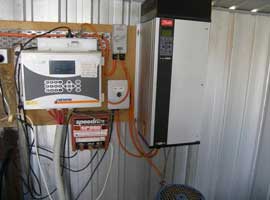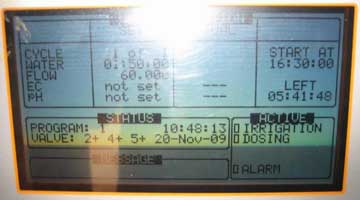Step 4.3.2 - What needs to be considered in the design stage?
Back to - Step 4.3 - What needs to be considered in the planning, design, cost and management of subsurface drip irrigation (SDI)?
Information in this section can aid in the design of an SDI system, however the design of the system will require the expertise and services provided by specialist SDI service providers and equipment suppliers. As the basis for the good design of an SDI system, answers are needed to the following questions
4.3.2.1 - What should be the emitter flow rate, spacing and depth?
Emitter flow rate and spacing must match the peak crop water demand, the crop type and the soil hydraulic characteristics of your field. An under-designed system that cannot deliver sufficient water to meet peak water demand will loose productivity on high water demand days. Conversely, emitters that discharge at rates too high for the soil hydraulic properties will deliver more water than can spread uniformly, leading to poor uniformity, surface ponding, runoff and excessive drainage.
For pasture, the ideal SDI system should provide a uniform distribution of irrigation water in the rootzone across the whole field. The selection of tape spacing depends on the crop type and soil hydraulic characteristics. A wider spacing reduces the initial investment cost of the system but may not fully irrigate the root zone between drip tapes and can cause pasture striping (Figure 16). An SDI pasture trial on a fine sandy loam soil in northern Victoria showed that a 1.4 m tape spacing could not adequately irrigate the rootzone midway between the dripper lines, generated more drainage and reduced yield compared to a spacing of 0.6 m (Figure 17).
 Figure 17. Cumulative pasture growth for different tape spacings in three seasons for a fine sandy loam soil in northern Victoria |
4.3.2.2 - How large an area can I develop?
The block size that can be irrigated depends on the maximum water application required by the crop, the pump capacity and pressure losses through your planned SDI system due to friction. These factors vary considerably depending on the system design and can involve complex calculations specific to your site and proposed layout. Your system design will usually involve trade-offs to consider between initial establishment costs such as pump capacity, pipe sizes and drip line spacings, and ongoing operational costs such as pumping duration and labour costs. You should consider a range of options before settling on a preferred design.
Further information
Queensland Department of Environment and Resource Management - Sub-surface drip irrigation: System design (external link).
4.3.2.3 - Do I need system automation?
One of the great advantages of SDI systems is their suitability for automation, and resultant savings in ongoing labour costs (Section 4.3.3.3). Relatively short, 1 to 4 days irrigation cycles are typical with these systems and manual operation of them requires constant attention and is time consuming. The automation unit (Figure 18) controls the system, stopping and restarting irrigations automatically, and applying different volumes of water to different blocks as required. Generally the SDI suppliers will provide support for programming these units. Fertigation can also be automatically applied with the irrigation water provided a fertiliser control unit (Section 4.3.1.2) is attached to the system.
(a) | (b) |
4.3.2.4 - How much energy is used and greenhouse gasses emitted?
The energy used by SDI systems depends on pump size, required lift and run time of the pump. For example, a 2.0 ha subsurface drip irrigation experiment with pasture in northern Victoria used 237 kilowatt hours (kWh) of electricity to pump each megalitre of water.
Based on energy consumption, the carbon dioxide equivalent greenhouse gasses emitted as a result of pumping water can be calculated. It is estimated that generating one kWh of electricity creates 0.001392 tonnes of carbon dioxide equivalent (CO2-eq) (Australian Greenhouse Office 2004), meaning that, in the example above, approximately 0.33 t CO2-eq was created pumping each megalitre of irrigation water. Recent work has highlighted that conversion from gravity supplied, surface irrigation to pressurised irrigation systems will usually save water due to higher application efficiencies, but that large increases in total farm energy consumption and CO2-eq emissions need to be considered carefully, given projected rises in energy costs associated with carbon emission reduction policies. In situations where the irrigation supply is pumped, such as where groundwater is the source of irrigation water, energy consumption of pressurised systems such as SDI compares much more favourably with surface systems (Minimising the environmental impact of irrigation systems through optimal energy and water use efficiency - Jackson, 2009).



